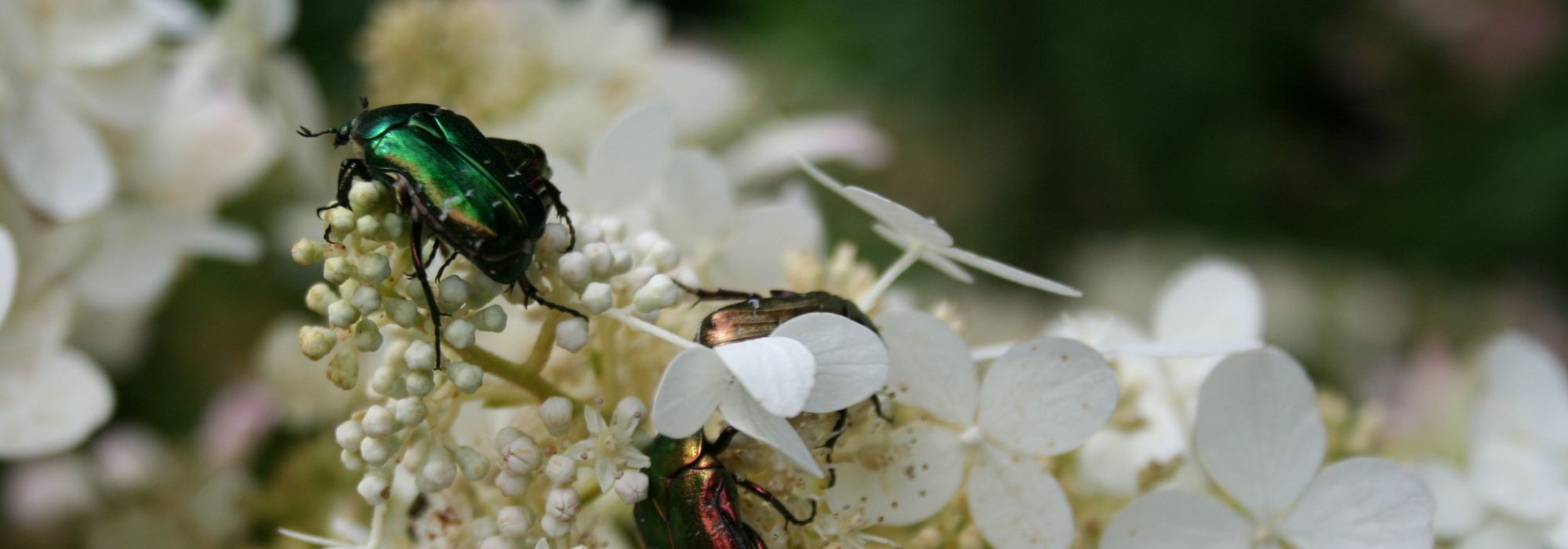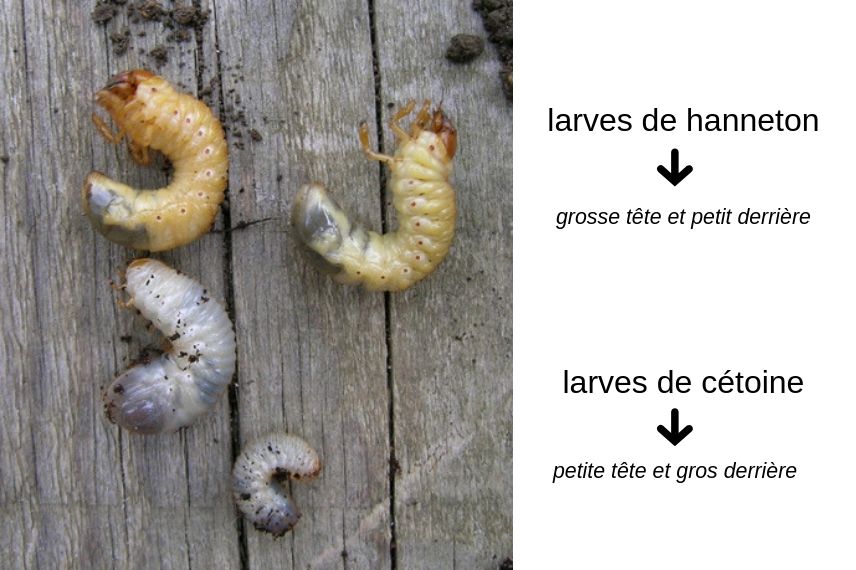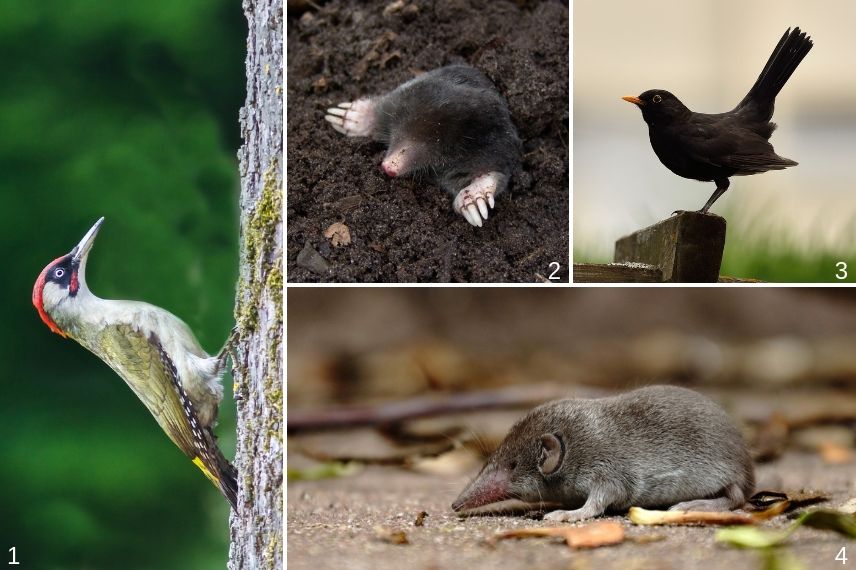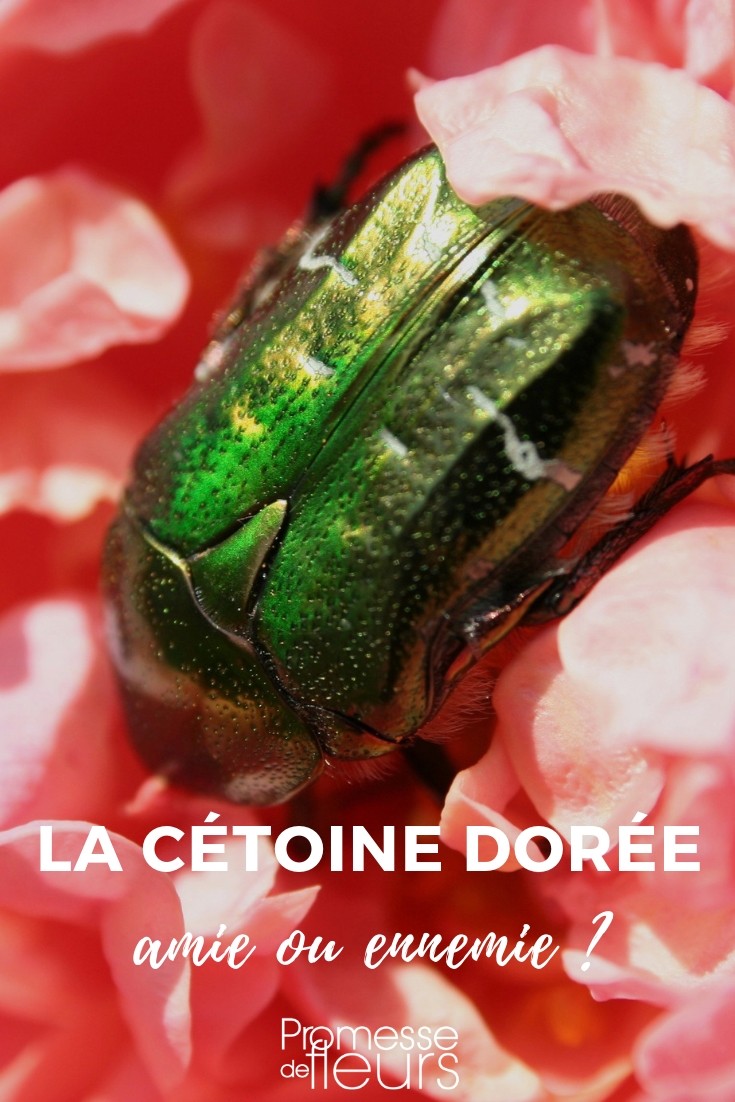
Golden rose chafer: all about this large garden insect
and no longer mistake it for a cockchafer!
Summary
Do you know the green rose chafer? Maybe not… Yet you’ve almost certainly already come across this large insect with an incredible metallic green colour in the garden. When it isn’t buzzing in your ear, it sprawls in large flowers such as roses and peonies, causing absolute mayhem. It is also very often encountered at the larval stage, in the form of large white grubs, in the compost bin or in planters… This big creature, which closely resembles a chafer, raises many questions: how to recognise it? Is it harmful to plants? Is it really a problem in the garden? Should it be eliminated or, on the contrary, left to get on with its life? Here are the answers!
Who is the golden rose chafer?
It is known by various poetic nicknames: rose chafer, catinette, émeraudine, … Its official name is: Golden cetonia or Cetonia aurata.
Golden cetonia at ‘imago’ stage
Golden cetonia is actually a coleopteran insect of the family Cetoniidae, quite common in Europe (but rarer in the north beyond Denmark). Adults measure between 13 and 20 mm and live only a few months. They are metallic green, punctate with white spots and sometimes show blue or red reflections. Like all beetles, they have a pair of reinforced wings called elytra. But their elytra are fused together and do not open as in the ladybird, for example. There is just a gap at the sides of the insect that allows its two other membranous wings to pass out, enabling it to fly (very skilfully, by the way!).
This insect likes sun and heat. Adults (insect adults are called imago) can be seen between April and October but it is especially active in high summer, between June and August.

Despite its great beauty, gardeners do not much like it because it has the unfortunate habit of feeding on nectar but also on stamens, which sometimes causes castration of the visited flower and becomes problematic for future fruiting (it will also sometimes eat a few petals). Golden cetonia is fond of flowers of roses, elder, umbellifers, some flowering bushes (Philadelphus, Crataegus, Syringa, …) but also… flowers of some fruit trees (apple, pear, plum, …) from which it inevitably reduces fruit production a little. But paradoxically it is also a pollinator that transfers pollen from one flower to another. Its flower‑damaging side is therefore balanced by its role as a garden beneficial. As usual, it is numbers that cause the problem. If numbers of golden cetonias are regulated by natural predators, everything will be fine (see below).
Golden cetonia can also consume some small ripe fruits such as those of elder, privet, spirea, serviceberry, …
It is important to distinguish these two feeding habits: the cetonias that eat flower stamens are those that have overwintered and emerge in spring to lay in June very small spherical white eggs before dying. Whereas the cetonias that feed on small fruits emerge in autumn, then overwinter and will lay the following year at the end of spring. Overwintering takes place under a pile of leaves, in a ramial woodchip mulch (BRF), in the compost heap or in an old tree stump.
Larva of the golden cetonia (not to be confused with the cockchafer’s)
The larva is described as melolonthoid: no need to panic, it is not an illness! It is simply the name given to certain scarab larvae shaped like large white comma‑shaped grubs, like those of cockchafers (Melolontha sp., hence the odd name…). The larva can live for several years in an old stump, the hollow of a dead tree, a ramial woodchip mulch or the compost heap before transforming. Indeed, the dead wood on which it feeds is not very nutritious, so the larva grows and develops slowly. At the end of its development, it will make itself a small shell fashioned from wood fibre and earth in which it can pupate to become a flying adult.
Although confusion is common, the cetonia larva is different from the cockchafer’s. To tell them apart is quite simple:
- the golden cetonia has a small brown head and a large rear,
- the cockchafer’s is the exact opposite: a large head and a small rear.
The cetonia larva also has smaller legs, erect hairs on its back and moves on its back rather than on its side like the cockchafer larva. Add to that a fundamentally different diet:
- the golden cetonia larva feeds only on dead wood,
- the cockchafer’s will nibble some roots… and that is why it is particularly feared.

Comparison between cockchafer larva (top) and cetonia larva (bottom)
You may also read
Pine processionary caterpillar: dangers and control methodsIts role in the garden and in nature
Golden chafer larva is saproxylophagous: this means it feeds, in its larval stage, only on dead wood. Consequently, it is an outstanding natural recycler and within a compost heap it even helps speed up ripening. It is not at all interested in roots of your plants but, it should be noted: if you have many larvae in a pot or planter, they will eventually damage some roots as they rummage through the substrate. The best solution is to remove as many as possible and move them to a small pile of dead wood or place them under a few dead leaves.
The adult, meanwhile, is a pollinator on a par with bees, bumblebees and butterflies… Indeed, flitting from flower to flower to feed, the golden chafer carries pollen on its hairs to the next flower. Unfortunately, it is not a very delicate insect and often behaves like a small buzzing bulldozer when it ‘attacks’ our flowers. Note that some flowers do not seem to suffer externally from the passage of the golden chafer: Philadelphus, Weigela, some of the wilder roses…
Its natural predators
Rose chafer larva is a delicacy for some insectivorous or omnivorous birds such as green woodpecker, blackbird or carrion crow. But it is also favoured by shrews and moles. All these predators help regulate chafer populations in a natural, balanced garden, thereby preventing excessive destruction of flowers.

Some natural predators of the chafer: 1-Green woodpecker ; 2-Mole ; 3-Blackbird ; 4-Shrew
The chafer is also preyed on by a solitary wasp called Scolia hirsuta, which lays its eggs directly in the larva. Wasp larvae then feed on the chafer larva from the inside (a clear example of parasitism). Sadly, this wasp is endangered and no longer able to regulate chafer populations effectively, notably Oxythyrea funesta (see below).
The imago, the adult chafer, is less preyed upon by insectivorous species. It’s still a big beast! But some occasionally get caught in spider webs or are captured by particularly determined insectivorous birds: robin or willow warbler.
You may also read
Aphid: identification and treatmentSome other garden chafers
Other insects of family Cetoniidae can be found in garden. Notably Grey chafer and Banded trichie.
Grey chafer Oxythyrea funesta, also known as sombre chafer is smaller than golden chafer and much less colourful: greyish-black, punctate with white spots. It lives much like its green cousin but may attack roots of plants. Moreover, it often causes more damage to flowers, notably flowers of actinidia, citrus trees or other fruit trees. It shares same predators as golden chafer.
Banded trichie Trichius fasciatus is much more likeable than previous cousin. It is entirely yellow and villous with orange elytra decorated with black bands. It also lives like golden chafer but causes no damage to flowers it visits: Asteraceae, roses, umbellifers, …
Many other chafers exist worldwide, especially in tropical regions. All more colourful than one another, some reach truly impressive sizes (even in entomological collection!). Goliaths, chafers from tropical Africa, can measure nearly 11 cm long. Imagine this huge creature circling around you… or worse… landing in your rose bed.
A few words from Oli
Alas, removal of all dead wood from forests and gardens has led to decline in golden chafer populations in our regions. Fortunately, foresters realised their mistake a few years ago and have begun leaving a few standing dead trees per hectare in forests, which helps restore a natural balance. Dead wood, being an entire ecosystem in its own right, provides food and shelter to many living organisms that will break it down and eventually “return” it to the soil. Leaving small piles of dead wood in the garden won’t take up much space and you can hide them behind a bush, for example, if you fear a loss of aesthetics. Many small and medium-sized creatures will thank you: hedgehogs, wood-boring insects, … and various fungi.
- Subscribe!
- Contents
































Feedbacks